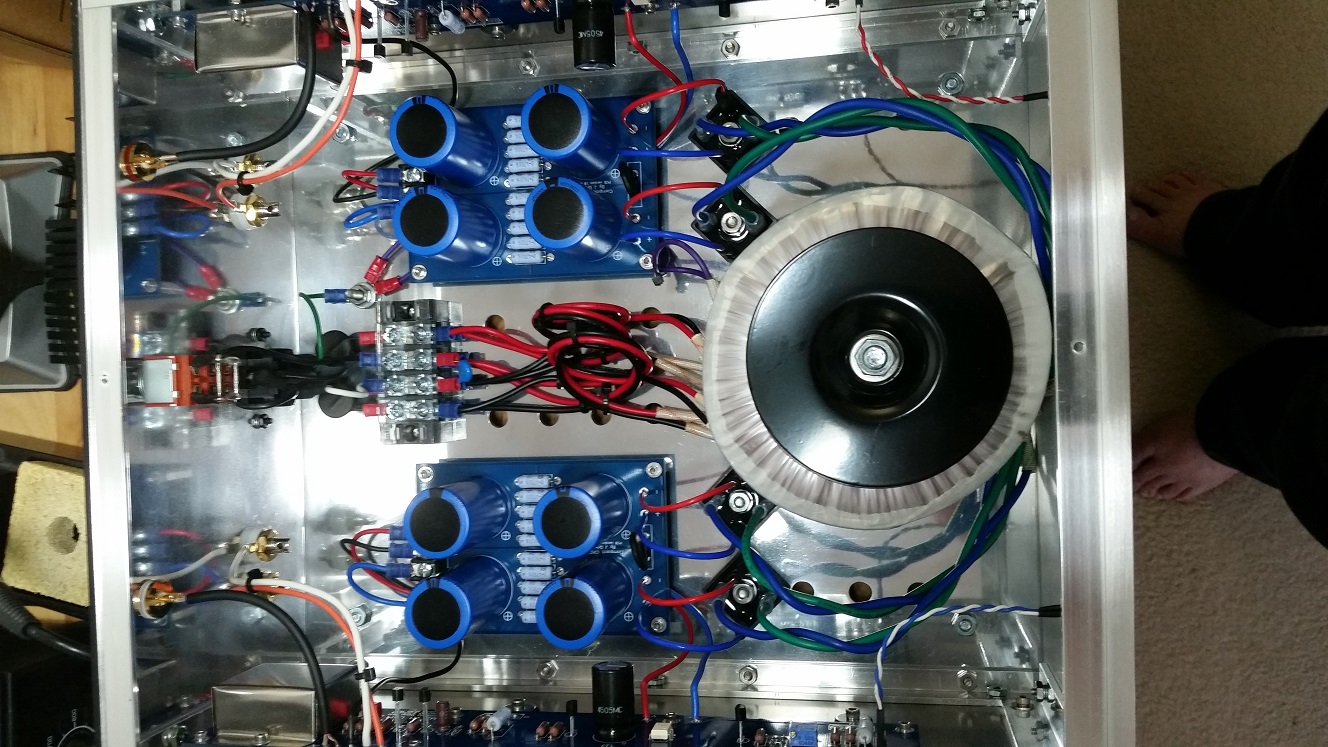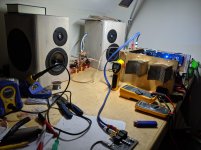Hi, looks interesting.
Just a heads up, on mine the adjustment pots worked backwards.
Something to watch for if bias starts to rise when switched on.
Just a heads up, on mine the adjustment pots worked backwards.
Something to watch for if bias starts to rise when switched on.
Hello to everybody!
I just finished my amp today ,solving the issues I had after a wrong bias 🙂...and I have to say that I`m very happy and surprised about the sound.It is indeed amazing.I like it a lot! Many thanks to Diyaudio for that and especially to Mr. Nelson Pass.
Though ,there is one single thing I would like to improve , if possible.I have the feeling the bass is a bit shy .Is it possible to add more weight to the bass somehow?
The bias was set to 0.51 V ( the mosfet second pin 62-63 degr C).
I have used 5.8 zenners and 3.3K resistors.
Thanks
I just finished my amp today ,solving the issues I had after a wrong bias 🙂...and I have to say that I`m very happy and surprised about the sound.It is indeed amazing.I like it a lot! Many thanks to Diyaudio for that and especially to Mr. Nelson Pass.
Though ,there is one single thing I would like to improve , if possible.I have the feeling the bass is a bit shy .Is it possible to add more weight to the bass somehow?
The bias was set to 0.51 V ( the mosfet second pin 62-63 degr C).
I have used 5.8 zenners and 3.3K resistors.
Thanks
Attachments
give it some time , then judge the sound
pull up those mains NTCs , away from base plate
tell us more about rest of your setup , so we can comment where exactly to look for more bassssssssssssssssssssss
pull up those mains NTCs , away from base plate
tell us more about rest of your setup , so we can comment where exactly to look for more bassssssssssssssssssssss
give it some time , then judge the sound
pull up those mains NTCs , away from base plate
tell us more about rest of your setup , so we can comment where exactly to look for more bassssssssssssssssssssss
Hi,
thanks for reply.
NTCs mean the red and blue power supply cables ? Sorry but I`m not familiar with this things.This is my first electronic thing ever build ! 🙂)
My setup is :
Cyrus XP2QX streamer
NAD M51 DAC
Kudos Super 20 A speakers
KIMBER Timbre interconnect
Cannare digital interconnect
Kimber PK 10 power cable
Wireworld Orbit speaker cable
Isotek Initium power cable
Wireworld power cable
PS: My main amp is a Plinius 9200.After I have heard the F6...well ...I think I have a problem 🙂)).If I can add some basss 🙂) Plinius is gone I`m afraid.
thanks
He means the CL-60s you have in series with the live line as inrush limiters. They are live inside, if by accident the coating comes off and they contact the chassis it will be live. How do i know? He said the same thing to me 😱)
F6 . if made correctly , can't be responsible for any bass deficiency in system
there is always possibility that 25W is not enough to make your ears happy , when combined with your speakers , but then it is not F6 as culprit , it is mismatch between speakers and amplification
for me - 180mm dia cones with 88db/1W/m sensitivity , married with 25W amp ...... isn't match made in heaven , if I'm expecting music bliss
if happy cruise is what's expected , then OK ( for several years I was happy with 15W amp and LS3/5 clones ) ....... I like and enjoy more efficient and more sensitive speakers , which mostly means they need to be bigger .....
there is always possibility that 25W is not enough to make your ears happy , when combined with your speakers , but then it is not F6 as culprit , it is mismatch between speakers and amplification
for me - 180mm dia cones with 88db/1W/m sensitivity , married with 25W amp ...... isn't match made in heaven , if I'm expecting music bliss
if happy cruise is what's expected , then OK ( for several years I was happy with 15W amp and LS3/5 clones ) ....... I like and enjoy more efficient and more sensitive speakers , which mostly means they need to be bigger .....
Whilst on that topic, what do people think about using these screw terminal blocks? I know they are used a lot, but I am always nervous about the quality of the contact between wires & the block, especially where large (ish) currents are involved. Any thoughts?
sole screw terminals I'm allowing in my builds are on caps , if I'm using bigguns (not snap-ins)
I am talking about that type:
https://www.amazon.com/Morris-22052-20A-Terminal-Block/dp/B005BGC3S0
I find when I used them with stranded wires, whilst the wire will conform to the shape of the block, if I try to yank it out the screw only catches on a few strands. Also it seems to always break some strands off.
With solid wires or tinned wires or leads, i worry that you will end with a small point contact which can't be good, unless you really tighten that screw down to the point it digs into the wire.
So whilst the blocks might rated at 20A or more, in general I don't consider them very safe.
https://www.amazon.com/Morris-22052-20A-Terminal-Block/dp/B005BGC3S0
I find when I used them with stranded wires, whilst the wire will conform to the shape of the block, if I try to yank it out the screw only catches on a few strands. Also it seems to always break some strands off.
With solid wires or tinned wires or leads, i worry that you will end with a small point contact which can't be good, unless you really tighten that screw down to the point it digs into the wire.
So whilst the blocks might rated at 20A or more, in general I don't consider them very safe.
Which is why I would move the inrush limiters to the psu board. Like the way Nelson does it (so masterfully):
https://browse.startpage.com/do/sho...sp=3249bfc2f6828d0df737b513318789c2&t=default
(not to mention the superb grounding)
https://browse.startpage.com/do/sho...sp=3249bfc2f6828d0df737b513318789c2&t=default
(not to mention the superb grounding)
Last edited:
The connector in your link is often referred to as EuroBlock and it is available in several sizes. There is a variant which contains a metal plate underneath the screw to press on to stranded wire.
I prefer this type which also has a screw driving a moving metal plate against a fixed one. It handles both bare stranded wire and fork style crimped terminals equally well. It also has a snap on clear cover to prevent accidental contact with the energized terminals.
Tb Electrical Waterproof Screw Wire Connector Pcb Brass Barrier Strip Terminal Block - Buy Electric Terminal Block,Terminal Block Connector,Ceramic Terminal Block Product on Alibaba.com
You can see it in use in my M2 clone build...

...documented in the https://www.diyaudio.com/forums/pass-labs/281520-official-m2-schematic-72.html#post4975080 thread.
I prefer this type which also has a screw driving a moving metal plate against a fixed one. It handles both bare stranded wire and fork style crimped terminals equally well. It also has a snap on clear cover to prevent accidental contact with the energized terminals.
Tb Electrical Waterproof Screw Wire Connector Pcb Brass Barrier Strip Terminal Block - Buy Electric Terminal Block,Terminal Block Connector,Ceramic Terminal Block Product on Alibaba.com
You can see it in use in my M2 clone build...
...documented in the https://www.diyaudio.com/forums/pass-labs/281520-official-m2-schematic-72.html#post4975080 thread.
I agree with you on the ones you linked also replaced the ones in my f6 for the bulkier type grimberg mentioned. Those are very nice! Digikey sells them.
The connector in your link is often referred to as EuroBlock and it is available in several sizes. There is a variant which contains a metal plate underneath the screw to press on to stranded wire.
I prefer this type which also has a screw driving a moving metal plate against a fixed one. It handles both bare stranded wire and fork style crimped terminals equally well. It also has a snap on clear cover to prevent accidental contact with the energized terminals.
Tb Electrical Waterproof Screw Wire Connector Pcb Brass Barrier Strip Terminal Block - Buy Electric Terminal Block,Terminal Block Connector,Ceramic Terminal Block Product on Alibaba.com
You can see it in use in my M2 clone build...

...documented in the https://www.diyaudio.com/forums/pass-labs/281520-official-m2-schematic-72.html#post4975080 thread.
not enough holes in that bottom plate
luckily , M2 is not hottest of FW amps
🙂
One of the reasons I use terminal blocks is that, for me, no build is ever final. I always go back in to improve one thing or another.
The number of holes in the bottom plate is adequate for both my M2 and F6 builds, which have identical cases. That was not the case for the first version of my KSA-50 clone cases, which I built as passively cooled monoblocks. I had to take them apart and add additional holes to the bottom plate. Sheva (unofficial F7) got enough holes first time around. 🙂

The number of holes in the bottom plate is adequate for both my M2 and F6 builds, which have identical cases. That was not the case for the first version of my KSA-50 clone cases, which I built as passively cooled monoblocks. I had to take them apart and add additional holes to the bottom plate. Sheva (unofficial F7) got enough holes first time around. 🙂
Attachments
@grimberg yeah that's a safer way to do it. I totally understand, I always tinker too.
btw DAMN these are some clean builds man!
btw DAMN these are some clean builds man!
chatziva,
the Euro terminal blocks you referred to in your post #1333 ("Lüsterklemmen" in Gernan) are meant to be used with solid wire, not stranded wire.
For stranded wires, the code calls for using ferrules on Litz / stranded wire for use with Euro terminal blocks. ("Aderendhülsen" in German)
For example:
Aderendhulsen bei reichelt elektronik
You crimp those onto the stripped ends of a stranded wire with the appropriate tool and then screw the ends down. The screw on the terminal blocks digs into the quite soft ferrule, making good contact. For each wire diameter, there is a dedicated ferrule size.
It is also not advised to screw tinned stranded ends into a Euro terminal block - from what had been teached to us in earlier times, apparently the solder can slowly "flow" under pressure, making the connection not long-term reliable.
I have used the ferrules with good success on all my builds, and for house installation / electrical equipment as well. No problems so far whatsoever.
Personally, I am not so much concerned with terminal blocks not giving a good enough connection with cables for high currents. I'm actually more concerned that the terminal blocks don't give a good enough connection (low-loss) for very low-level signals (input signal connection, etc.). I don't use them for this purpose, mostly soldering, though the PCB-mounted terminals do work well for me:
Spring terminals, screw terminals at reichelt elektronik
These work well also with very thin wires (down to AWG30) and with stranded wire also; don't use ferrules with those.
Best regards,
Claas
the Euro terminal blocks you referred to in your post #1333 ("Lüsterklemmen" in Gernan) are meant to be used with solid wire, not stranded wire.
For stranded wires, the code calls for using ferrules on Litz / stranded wire for use with Euro terminal blocks. ("Aderendhülsen" in German)
For example:
Aderendhulsen bei reichelt elektronik
You crimp those onto the stripped ends of a stranded wire with the appropriate tool and then screw the ends down. The screw on the terminal blocks digs into the quite soft ferrule, making good contact. For each wire diameter, there is a dedicated ferrule size.
It is also not advised to screw tinned stranded ends into a Euro terminal block - from what had been teached to us in earlier times, apparently the solder can slowly "flow" under pressure, making the connection not long-term reliable.
I have used the ferrules with good success on all my builds, and for house installation / electrical equipment as well. No problems so far whatsoever.
Personally, I am not so much concerned with terminal blocks not giving a good enough connection with cables for high currents. I'm actually more concerned that the terminal blocks don't give a good enough connection (low-loss) for very low-level signals (input signal connection, etc.). I don't use them for this purpose, mostly soldering, though the PCB-mounted terminals do work well for me:
Spring terminals, screw terminals at reichelt elektronik
These work well also with very thin wires (down to AWG30) and with stranded wire also; don't use ferrules with those.
Best regards,
Claas
Last edited:
Thanks Claas yeah i agree with everything you said. I have used the level clamp types on power supply applications (i think from wago) and i like them a lot, suitable for both solid & stranded wire, very strong connection.
It sings!
After fixing a backwards led, have been edging the bias up between listening sessions. [PC-Khadas Tone Board, no preamp]
At the moment I have .460v across R2, offset less than .005v, and heatsink centers at 40-41C. Amp has been on for several hours, it got up to 45C when I turned the AC off (83 ambient).
Not sure I have something to check pin2 of the jfet. I think I can get to .5v without fans, but will see. [if I go that way, was thinking of 40mm or so fans on the ends of the heatsinks blowing in, with a pair of 67F050P Sensata / AIRPAX Bimetal Disc Thermostats to turn them on at 50C]. Dead silent between tracks.
I've thrown a variety of music at it, and it just sounds terrific - solid fast bass, musical in all ranges. Will take it downstairs and try it on the bigger speakers [Jon Marsh's Modula MTM tower version] once I get it enclosed.
I saw John Mayall live a few nights ago, so I cued up his 2019 Album "Nobody Told Me" and apart from the better production values of the album, they sounded very close. At 85, John has a little experience in getting the house rockin -
Please excuse the crossovers on my small speaker project, need to take some measurements to see how close I got to the xsim, and get a couple bigger caps to replace my cobbled together versions before I wire them up right and stick them inside. They sound darn good to my ear, with solid low bass, and typical Seas metal dome upper end. (the bass partly due to the PR, part to where they are sitting on a large desk in an attic room.
I think some form of a preamp might be next. Thank you to NP, the very helpful guide creators, and all here.
Michael
After fixing a backwards led, have been edging the bias up between listening sessions. [PC-Khadas Tone Board, no preamp]
At the moment I have .460v across R2, offset less than .005v, and heatsink centers at 40-41C. Amp has been on for several hours, it got up to 45C when I turned the AC off (83 ambient).
Not sure I have something to check pin2 of the jfet. I think I can get to .5v without fans, but will see. [if I go that way, was thinking of 40mm or so fans on the ends of the heatsinks blowing in, with a pair of 67F050P Sensata / AIRPAX Bimetal Disc Thermostats to turn them on at 50C]. Dead silent between tracks.
I've thrown a variety of music at it, and it just sounds terrific - solid fast bass, musical in all ranges. Will take it downstairs and try it on the bigger speakers [Jon Marsh's Modula MTM tower version] once I get it enclosed.
I saw John Mayall live a few nights ago, so I cued up his 2019 Album "Nobody Told Me" and apart from the better production values of the album, they sounded very close. At 85, John has a little experience in getting the house rockin -
Please excuse the crossovers on my small speaker project, need to take some measurements to see how close I got to the xsim, and get a couple bigger caps to replace my cobbled together versions before I wire them up right and stick them inside. They sound darn good to my ear, with solid low bass, and typical Seas metal dome upper end. (the bass partly due to the PR, part to where they are sitting on a large desk in an attic room.
I think some form of a preamp might be next. Thank you to NP, the very helpful guide creators, and all here.
Michael
Attachments
- Home
- Amplifiers
- Pass Labs
- F6 Illustrated Build Guide



